Thai Language
Reach 66M Thai Speakers with Expert Translation Services
In Thai there are at least five different levels of style and address based on factors like the person you're speaking to and the social context. The tone, vocabulary and even verb forms change to reflect respect and hierarchy.
You feel it is high time you focus on what matters most - your clients? We can assist.
Why Professional Thai Translation Requires Expertise?
The Written Language
Thai translation is a combination of deep cultural roots, honorifics, and unique linguistic structure. At 1-StopAsia our Thai linguists don’t just speak the language, they live it. That’s how we ensure every word we deliver is both accurate and culturally aligned.
Language and Culture
Thai is full of nuance – polite particles, indirect phrasing, and words with no direct English match. Great translation takes more than fluency – it takes deep cultural understanding.
Hierarchy and Honorifics
Respect is built into every sentence in Thai. Whether you’re talking to a friend, a colleague or a teacher, the vocabulary and tone shift dramatically. Thai has multiple levels of formality and even an entirely different set of words for speaking to monks and the royal family.
The Sound System
Thai is also phonetically rich. It includes complex vowel combinations like diphthongs(gliding vowels) and tones that can change a word’s meaning entirely.
The Spoken Language
Spoken Thai is more different and complex which makes translations even more challenging.
Dialects and Accents:
Thai has four main regional accents: Central (standard), which is the main accent, Northern, Northeastern, and Southern. Understanding the differences between them is key to making your message feel natural. Each region has its unique vocabulary, rhythms, and expressions and even simple phrases like “It’s okay” can vary:
Central Thai: ไม่เป็นไร
Southern: ไม่พรือ
Northeastern: บ่เป็นหยัง
Northern: บ่อเป็นหยังเจ้า
Tone
Thai has five distinct tones and changing them can completely change the meaning of a word. For example, suay (สวย) means “beautiful,” while suay with a different tone (ซวย) means “unlucky.” This makes accurate tone usage essential not just for clarity but also to avoid awkward or unintended meanings.
Get exclusive insights into the world of translation, localization, and the language industry.
How We Can Support You
Native Translators with Local Expertise
Our Thai linguists are native speakers with deep understanding of the language and culture. Their cultural expertise ensures that your content is not only translated accurately but also resonates with the local audience.
25 Years of Expertise
Through our 25 years in the industry, we’ve built a team of professionals who truly understand the challenges of translation workflows. They quickly assess clients’ needs and provide professional translation services to match them. Always ready to assist with your inquiries, they also save you time while delivering you accurate translations.

